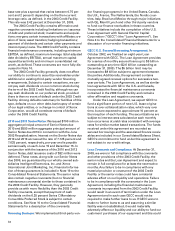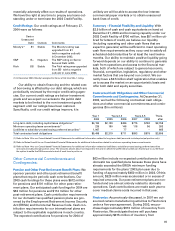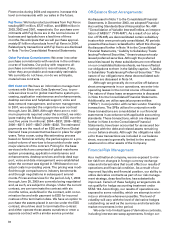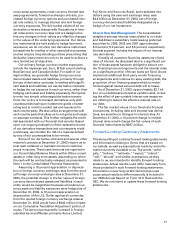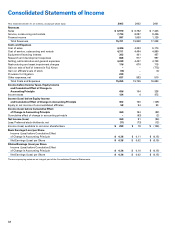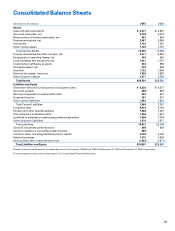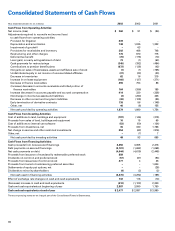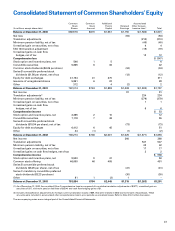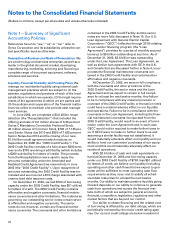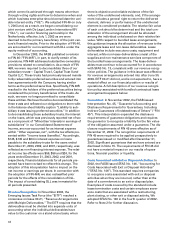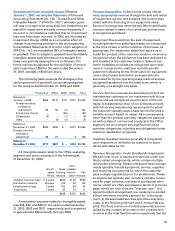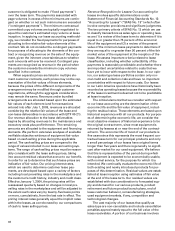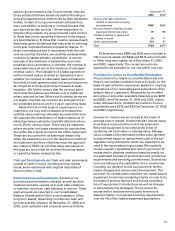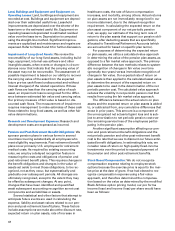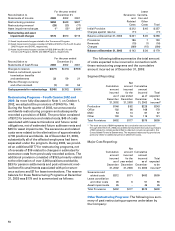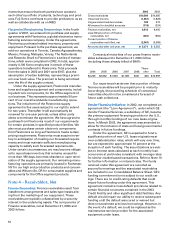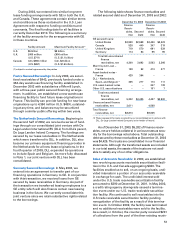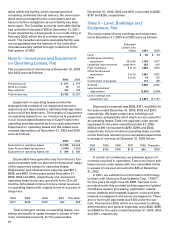Xerox 2003 Annual Report Download - page 46
Download and view the complete annual report
Please find page 46 of the 2003 Xerox annual report below. You can navigate through the pages in the report by either clicking on the pages listed below, or by using the keyword search tool below to find specific information within the annual report.
44
there is objective and reliable evidence of the fair
value of the undelivered elements, and, if the arrange-
ment includes a general right to return the delivered
element, delivery or performance of the undelivered
element is considered probable. The relative fair value
of each unit should be determined and the total con-
sideration of the arrangement should be allocated
among the individual units based on their relative fair
value. With respect to bundled lease arrangements,
this guidance impacts the allocation of revenues to the
aggregate lease and non-lease deliverables. Lease
deliverables include executory costs, equipment and
interest, while non-lease deliverables consist of the
supplies and non-maintenance services component of
the bundled lease arrangements. The lease deliver-
ables must continue to be accounted for in accordance
with SFAS No. 13, consistent with our revenue recog-
nition policies. The guidance in this issue was effective
for revenue arrangements entered into after June 30,
2003. EITF 00-21 did not, and is not expected to, have a
material effect on our financial position or results of
operations. A full description of our revenue recogni-
tion policy associated with bundled contractual lease
arrangements appears below.
Guarantees: In November 2002, the FASB issued
Interpretation No. 45, “Guarantor’s Accounting and
Disclosure Requirements for Guarantees, Including
Indirect Guarantees of Indebtedness of Others” (“FIN
45”). This interpretation expanded the disclosure
requirements of guarantee obligations and requires
the guarantor to recognize a liability for the fair value
of the obligation assumed under a guarantee. The dis-
closure requirements of FIN 45 were effective as of
December 31, 2002. The recognition requirements of
FIN 45 were required to be applied prospectively to
guarantees issued or modified after December 31,
2002. Significant guarantees that we have entered are
disclosed in Note 15. The requirements of FIN 45 did
not have a material impact on our results of opera-
tions, financial position or liquidity.
Costs Associated with Exit or Disposal Activities: In
2002, the FASB issued SFAS No. 146, “Accounting for
Costs Associated with Exit or Disposal Activities”
(“SFAS No. 146”). This standard requires companies
to recognize costs associated with exit or disposal
activities when they are incurred, rather than at the
date of a commitment to an exit or disposal plan.
Examples of costs covered by the standard include
lease termination costs and certain employee sever-
ance costs that are associated with a restructuring,
plant closing, or other exit or disposal activity. We
adopted SFAS No. 146 in the fourth quarter of 2002.
Refer to Note 2 for further discussion.
which control is achieved through means other than
through voting rights and how to determine when and
which business enterprise should consolidate the vari-
able interest entity (“VIE”). We adopted FIN 46 on July
1, 2003 and, as a result, we began consolidating our
joint venture with De Lage Landen International BV
(“DLL”), our vendor financing partnership in the
Netherlands, effective July 1, 2003 as we were
deemed to be the primary beneficiary of the joint ven-
ture’s financial results. Prior to the adoption of FIN 46,
we accounted for our investment with DLL under the
equity method of accounting.
In December 2003, the FASB published a revision
to FIN 46 (“FIN 46R”), in part, to clarify certain of its
provisions. FIN 46R addressed substantive ownership
provisions related to consolidation. As a result of FIN
46R, we were required to deconsolidate three of our
subsidiary trusts— Capital Trust I, Capital Trust II and
Capital LLC. These trusts had previously issued manda-
torily redeemable preferred securities and entered into
loan agreements with the Company having similar
terms as the preferred securities. Specifically, FIN 46R
resulted in the holders of the preferred securities being
considered the primary beneficiaries of the trusts. As
such, we were no longer permitted to consolidate
these entities. We have therefore deconsolidated the
three trusts and reflected our obligations to them with-
in the balance sheet liability caption “Liability to sub-
sidiary trusts issuing preferred securities.” In addition
to deconsolidating these subsidiary trusts, the interest
on the loans, which was previously reported net of tax
as a component of “Minorities’ interests in earnings of
subsidiaries” in our Consolidated Statements of
Income, are now accounted for as interest expense
within “Other expenses, net”, with the tax effects pre-
sented within “Income taxes (benefits).” Accordingly,
$145, $145 and $64 in interest expense on loans
payable to the subsidiary trusts for the years ended
December 31, 2003, 2002, and 2001, respectively, was
reflected as non-financing interest expense. The relat-
ed income tax effects were $56, $56 and $24, for the
years ended December 31, 2003, 2002, and 2001,
respectively. Financial statements for all periods pre-
sented have been revised to reflect this change. The
adoption of this interpretation had no impact on the
net income or earnings per share. In connection with
the adoption of FIN 46R, we also reclassified prior
periods for the effects of the consolidation of DLL.
The impact of consolidating DLL was immaterial for
all periods presented.
Revenue Recognition: In November 2002, the
Emerging Issues Task Force (the “EITF”) reached a
consensus on Issue 00-21, “Revenue Arrangements
with Multiple Deliverables.” The EITF requires that the
deliverables must be divided into separate units of
accounting when the individual deliverables have
value to the customer on a stand-alone basis, when


